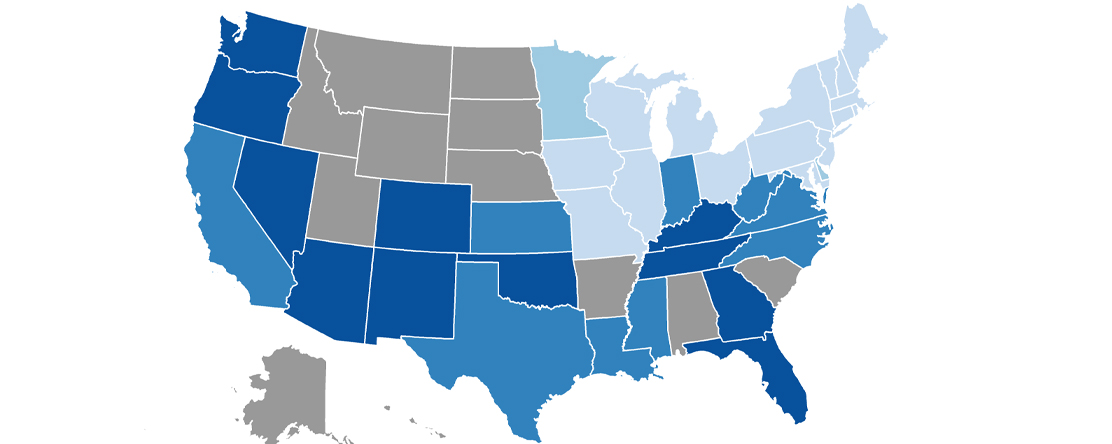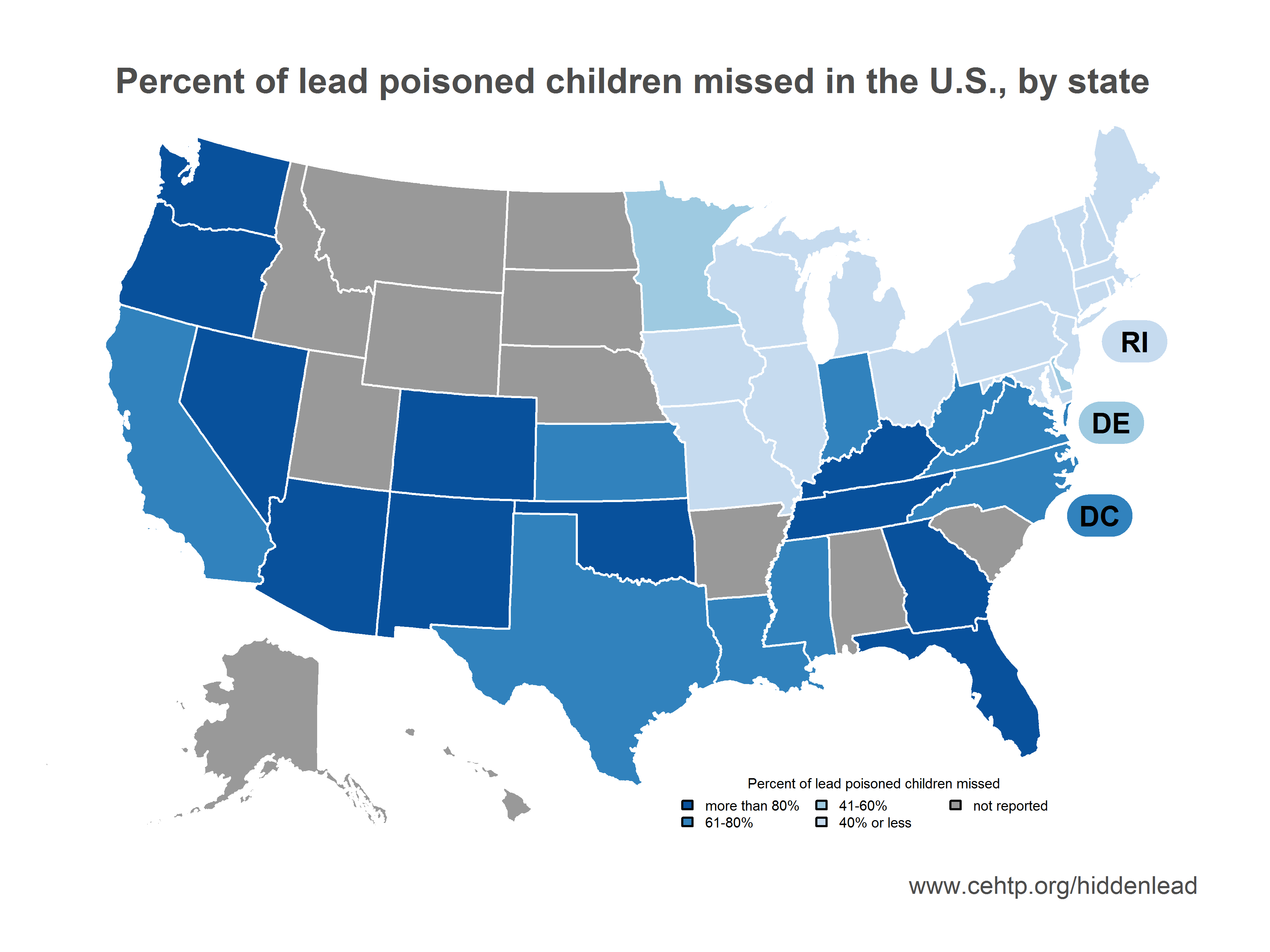
Press Release
A Third of Children Exposed to Lead in the U.S. Likely Undiagnosed
-
Focus Areas
Environmental Health -
Expertise
Research – Surveillance

Pediatrics study reveals states where more than 80% of lead-poisoned children remain unidentified
Oakland, CA — As concerns about lead exposure peak across the U.S., a new PHI study published in Pediatrics indicates that lead reporting may be capturing just 2 out of every 3 children poisoned by lead. “Assessing Child Lead Poisoning Case Ascertainment in the US, 1999-2010,” found states where more than 80% of lead-poisoned children remain unidentified—and researchers expect that testing rates have only declined in the subsequent years. Interactive maps showing detailed findings and estimates of lead poisoning rates for local areas are available on www.cehtp.org/hiddenlead.
 Commonly cited estimates of lead exposure in children are based on results of lead tests conducted by medical providers and reported to the CDC. However, since lead testing is not required for all children in the United States, these estimates are incomplete.
Commonly cited estimates of lead exposure in children are based on results of lead tests conducted by medical providers and reported to the CDC. However, since lead testing is not required for all children in the United States, these estimates are incomplete.
To assess the completeness of lead reporting and the effectiveness of state child lead testing efforts, researchers at PHI’s California Environmental Health Tracking Program used data from the National Health and Nutrition Examination Survey (NHANES) to calculate the number of lead exposed children. Specifically, for each state, researchers estimated the prevalence of children aged 12 months to 5 years with elevated blood lead levels (EBLL, defined as 10 µg/dL and higher) from 1999-2010, the years in which the most accurate data for estimating prevalence were available. These prevalence estimates were compared to the numbers of EBLL cases reported to the CDC during this time period.
Researchers estimate that:
- In 23 of 39 states where data were available, more than half of children with EBLL were not identified
- Nationally, only 64% of children with EBLL were identified
- In California, only 37% of children with EBLL were identified
Approximately 1.2 million cases of EBLL are believed to have occurred during this period. Of the 944,000 cases that occurred in states that were reporting data to the CDC at the time, only 607,000 cases (64%) were actually identified and reported to the CDC.
“The numbers of children with lead poisoning we know about are already frighteningly high—especially since lead poisoning is preventable,” said Eric Roberts, MD, PhD, pediatrician and co-principal investigator of the California Environmental Health Tracking Program at the Public Health Institute. “But now we know that many more children who have been exposed to lead are not tested, not counted and not treated. Without the true numbers, we can’t help the children who have been poisoned, or root out how and why so many children are being poisoned in the first place.”
Childhood lead poisoning has often been viewed as a problem confined to the Northeast and Midwest, but results of the study indicate that lead poisoning impacts children in all regions of the United States. While the largest numbers of reported cases were in the Northeast and Midwest, the study found that the largest numbers of children with EBLL resided in the South. Pronounced under-reporting took place in both the South and West.
No amount of lead in the body is known to be safe—yet despite the well-known risks from lead exposure, guidance for physicians on the testing of blood lead levels has not been standardized.
“As long as the current system of lead testing is in place, large numbers of children will continue to be poisoned and no one will know about it,” said Roberts. “These findings suggest that physicians need to be much more aggressive in testing the blood lead levels of children in their care, and be prepared to counsel parents and guardians on actions that can be taken if their child tests positive.”
After 2010, due to changes in the data collected by NHANES, medical lead testing data have become the sole source of information on how many children are exposed to lead in each state. By assessing the completeness and consistency of lead testing and reporting leading up to this year, researchers determined that lead testing data are of limited utility for generating estimates of lead exposure. Evidence suggests that there have not been widespread improvements in lead testing by medical providers since 2010: In 2015, only 38% of children 1-2 years old continuously enrolled in Medicaid had a lead test, despite legal requirements for these children to be tested. This suggests that under testing continues to be an issue.
Studies show that EBLL in children costs the U.S. an estimated $50 billion each year in lost economic productivity. PHI researchers found that, in California, EBLL costs an estimated $8-11 billion for children born in a single year.
###
For more information, contact Ann Whidden at awhidden@phi.org, 510-285-5631 or 415-425-5157. Click here to download additional images and materials.
About the California Environmental Health Tracking Program
The California Environmental Health Tracking Program (CEHTP) is a program of the Public Health Institute. CEHTP provides data and information on diseases and environmental threats to inform environmental and public health programs, research, and policies.
About the Public Health Institute
The Public Health Institute, an independent nonprofit organization, is dedicated to promoting health, well-being and quality of life for people throughout California, across the nation and around the world.
More Updates
Work With Us
You change the world. We do the rest. Explore fiscal sponsorship at PHI.
Support Us
Together, we can accelerate our response to public health’s most critical issues.
Find Employment
Begin your career at the Public Health Institute.



